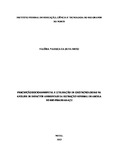Percepção socioambiental e utilização de geotecnologias na análise de impactos ambientais da extração mineral de argila no rio piranhas-açu, trecho do município de Itaja-RN
Data
2023-06-26Autor
Brito, Valéria Valesca da Silva
http://lattes.cnpq.br/1892685373802422
Metadado
Mostrar registro completoResumo
The mining activity of clay extraction is responsible for generating employment and income, however it also causes great damage to the environment, mainly related to major environmental impacts and changes in locations as a result of the way the product is extracted. The economy of the municipality of Itajá/RN is based on the red ceramic industry, based on the production of ceramic artifacts, such as tiles, bricks and flagstones. This activity has become important for the population because it is the main economic branch of employability and income generation and also because its raw material, clay ore, is in abundance, with a location that facilitates its exploitation. The clay ore extraction pits are located in a large part of the rural area of the municipality, as well as close to the Piancó-Piranhas-Açu river, which causes a series of environmental damages. Therefore, this work aims to identify the environmental impacts of mining activity on the banks of the Piranhas Açu River, in the stretch belonging to the city of Itajá-RN, and seek mitigating measures that aim to reduce the negative effects of this activity. This assessment took place through on-site visits to prepare interaction matrices, questionnaires for socio-environmental assessment of the population in relation to the impacts that the activity can cause and also the use of the map overlay method for multi-temporal analyzes of the years 2001, 2013 and 2021 of the environmental impacts of clay extraction. With the results found, it was possible to identify several environmental aspects and impacts based on Leopold's interaction matrix that cause degradation in the physical, biotic and anthropic environments. It was found from the environmental perception questionnaires that the residents of the city of Itajá disregard the environment as an important factor for their survival and when producing maps through remote sensing, it is clear that there is continuous degradation in the space investigated. , where it is understood that if there are no interventions by the protection bodies. The municipality may be doomed to desertification, putting the economy and ecosystems at risk.




